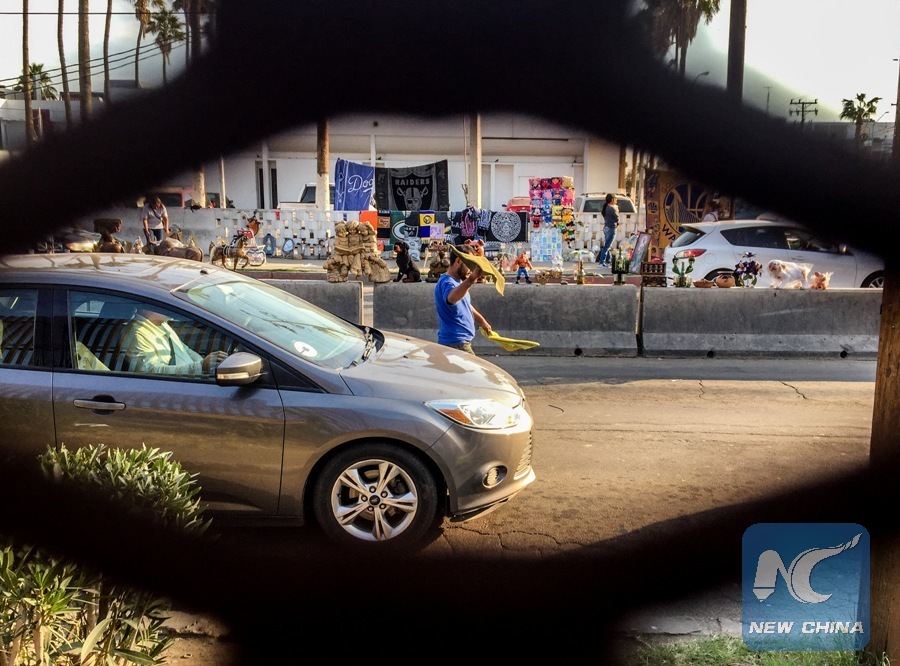
Image taken on Feb. 3, 2017, shows a view of a section of the already existed border wall and fences between the United States and Mexico in California border city Calexico. U.S. President Donald Trump signed an executive order to build "a large physical barrier" between the U.S. and Mexico on Jan. 25, 2017. (Xinhua/Zhang Chaoqun)
by Huang Heng, ChenChen Shen
EL CENTRO, the United States, Feb. 6 (Xinhua) -- "Trump's border wall? ... Well, I think it's just kidding," Brenda Gonzalez joked around with his customers.
Originally from Mexico, Gonzalez is now a front desk manager at a Holiday Inn Express hotel in El Centro, California, 350 kilometers southeast to Los Angeles.
"Tell Trump to offer me a job when he starts to build the wall," A Caucasian co-worker said to Gonzalez, while getting ready to start his shift at the front desk.
Just a few months ago, this young man moved from Eastern Los Angeles to the largest city in the Imperial Valley, only 6.8 kilometers north of Calexico, a smaller town divided by fence with Mexicali, a Mexican city.
This three-story Holiday Inn Express is a standing-out building in El Centro, owned by an immigrant from Eastern India.
Ten years ago before this hotel first opened to business, local residents in El Centro thought motels were good enough for this city since only truck drivers would sleep over at town. But now, with the development of border trading, El Centro is growing and getting international, with chain restaurants and supermarkets. In Calexico, many of the shop owners are Korean.
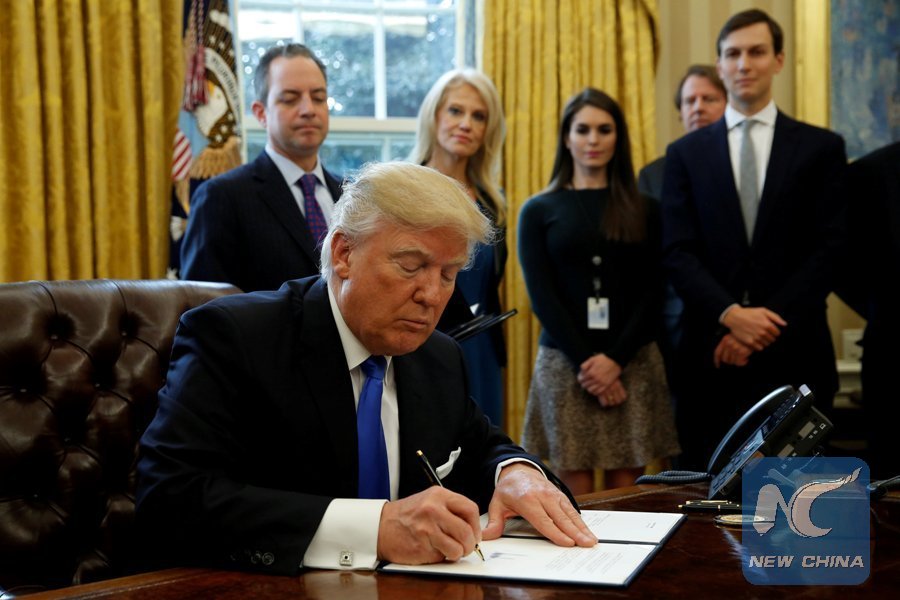
U.S. President Donald Trump signs an executive order to advance construction of the Keystone XL pipeline at the White House in Washington January 24, 2017. (REUTERS/Kevin Lamarque)
U.S. President Donald Trump signed two executive orders on Jan. 25 to have the Department of Homeland Security begin planning, designing and building a "physical barrier" along the U.S.-Mexico border, identify undocumented immigrants, and remove those who have criminal records.
The cost of the wall to block off the nearly 3200 km-long border has been estimated to be anything from 8 to 25 billion U.S. dollars.
However, for local residents living in the border cities, the wall is a ridiculous idea.
"They won't build that wall, even if they did, nothing will change. There used to have those thin fences along the border, now they've replaced them with stronger metal fences. But people still come across the border to buy things or work. I do not think a wall will stop them." Vincent, a salesman at El Centro Walmart who only gave his first name, told Xinhua.
The "ugly iron fences" he talked about are about 6 meters high and located in Calexico.
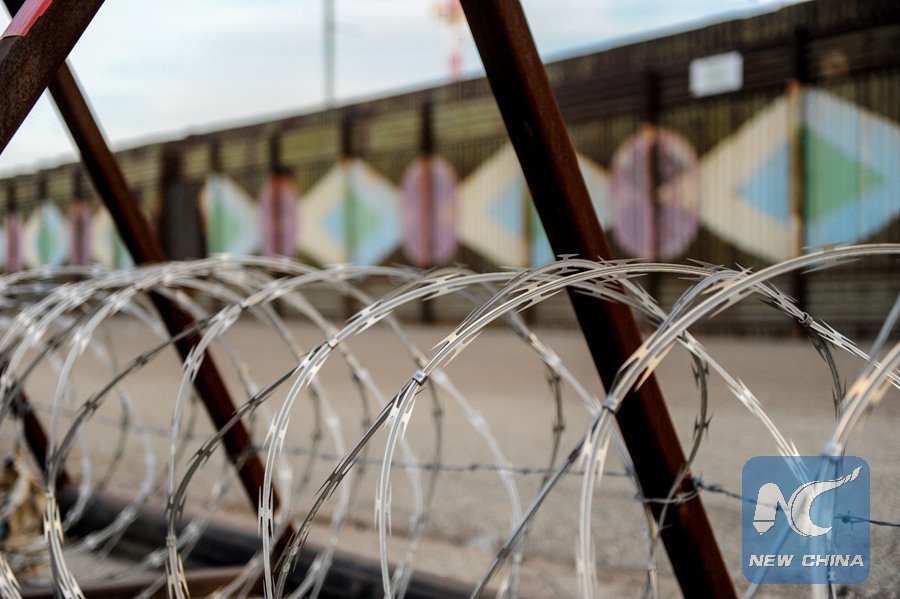
Image taken on Feb. 3, 2017, shows a view of a section of the already existed border wall and fences between the United States and Mexico in California border city Calexico. U.S. President Donald Trump signed an executive order to build "a large physical barrier" between the U.S. and Mexico on Jan. 25, 2017. (Xinhua/Zhang Chaoqun)
Vincent, immigrated from Mexico years ago, believed that income difference was one of the major reasons for illegal immigrants to enter U.S. from Mexico.
"They only make 4 dollars a day over there, but here, they make a few times more than that. One day here equals to one week there. Even if they get caught and sent back, they can come back later with Border Crossing Card," Vincent said.
Border Crossing Card (BCC) allows Mexican citizens to visit the border areas of the United States when entering by land or sea directly from Mexico for less than 72 hours.
"The only thing that will stop the flow of migrants is improved conditions in migrants' countries of origin: Mexico, Guatemala, Honduras and other areas," Ev Meade, director of the University of San Diego's Trans-Border Institute told local KPBS radio last December.
However, the reality was much more complicated than researchers' words.
Vincent and all of the other local residents told Xinhua that, most of the Mexicans working in El Centro, including legal and illegal immigrants, did not really want to live in the U.S., they just want to make money in the U.S. and spend them in Mexico.
Most of them go back to Mexico every week or even everyday. It is the U.S. employers that do not want them to leave. Not many locals can do or want to do the work that Mexicans are doing. Vincent said he had a part-time job repairing air-conditioners, only a few people in the agriculture-based Imperial Valley know how to do it.
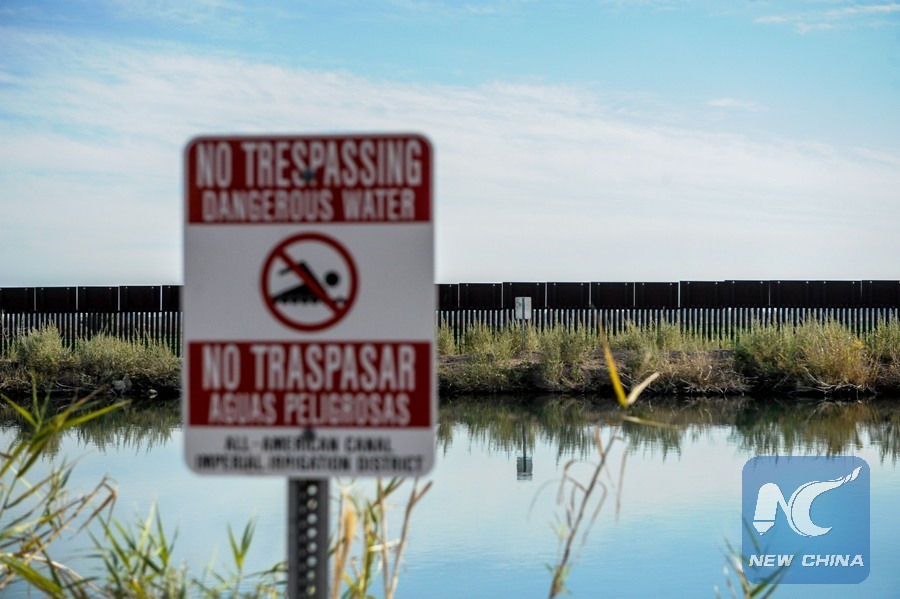
Image taken on Feb. 3, 2017, shows a view of a section of the already existed border wall and fences between the United States and Mexico in California border city Calexico. U.S. President Donald Trump signed an executive order on to build "a large physical barrier" between the U.S. and Mexico on Jan. 25, 2017. (Xinhua/Zhang Chaoqun)
Statistics showed that "illegal immigrants" contributed a lot to American economy.
A cross section of California leaders in business, education, law enforcement and religion testified at Supreme Court of the United States last year that a quarter of illegal immigrants in the U.S. lived in California, which accounted for 7 percent of the California population, meanwhile, over 34 percent of agriculture laborers, 22 percent of manufacturing laborers and 21 percent of construction workers were illegal immigrants.
"The undocumented workforce alone made over 130 billion GDP for California last year, which was more than the entire respective GDPs of 19 other states." they said in a court brief.
"If you build a 20-foot wall, they (illegal immigrants) will build a 21-foot ladder and they will try to get in," said Shawn Moran, vice-president of the National Border Patrol Council last November during an interview. Nevertheless, he also stated that fence or wall was, at least, a warning that would eliminate incentives for migrations to enter the country illegally.
David FitzGerald, co-director of University of California San Diego's Center for Comparative Immigration Studies, pointed out that a tall wall would also make crossing border more dangerous, which may increase the death number.
U.S. started to build the existing barrier since the 1990s. It is now over 700 miles (1,180 Kilometers) and about one-third of the total length of the land border. Since then, about 7,000 to 10,000 people died trying to enter the United States illegally.
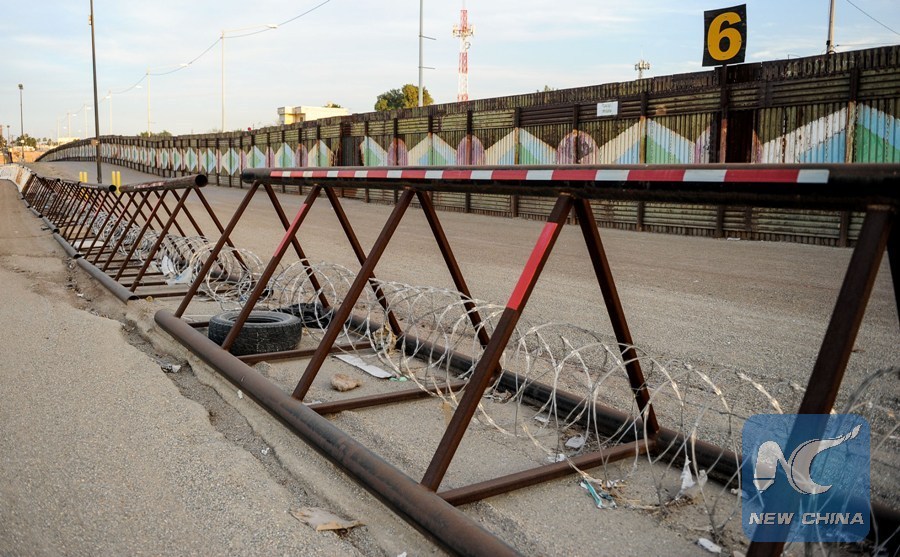
Image taken on Feb. 3, 2017, shows a view of a section of the already existed border wall and fences between the United States and Mexico in California border city Calexico. U.S. President Donald Trump signed an executive order to build "a large physical barrier" between the U.S. and Mexico on Jan. 25, 2017. (Xinhua/Zhang Chaoqun)
Immigration experts and human right groups also raised the question that if there was a wall where illegal immigrants could not pass, would they try to enter the US from the sea? If the answer is yes, then tragedies happening in Mediterranean now could happen here.
"Why waste the money?" Leo Poldo, the manager at a local Italian restaurant called Marino, believed that Trump's wall plan was a "hoax" or a "political game."
Trump is committed to renegotiating North American Free Trade Agreement (NAFTA) and if partners refuse conditions that give American workers a good deal then the president would give notice of the United States' intent to withdraw from NAFTA.
For residents and people doing business in Imperial Valley, this threat, which could lead to a tax wall, bothered them more than the border wall.
The border wall is more like a symbolic gesture. However, local businessmen said that the "tax wall" could bring down the local economy, and as a result more people would try to climb over that border wall.
According to the Imperial County Comprehensive Economic Development Strategy, Mexico is California's highest ranking trading partner. Over 30 percent of the trading products come through the two land ports in Calexico. The total value of the trading products in 2013 was worth at 13.1 billion dollar.
Border cities, such as El Centro and Calexico, thrived on international trading in last decade. Indian, Korean, and Chinese businessmen came to invest because of international trading. Moreover, Laborers living on the other side of the border had no strong willing to immigrate to the United States as they found a comfortable post in global economic chain.
The Imperial Valley-Mexicali Binational Alliance held a seminar on this issue at CETYS University in Mexicali last Thursday. They reached conclusions that they had to talk to the U.S. And Mexican governments, to prepare for the worst time and to believe there would always be a way.

